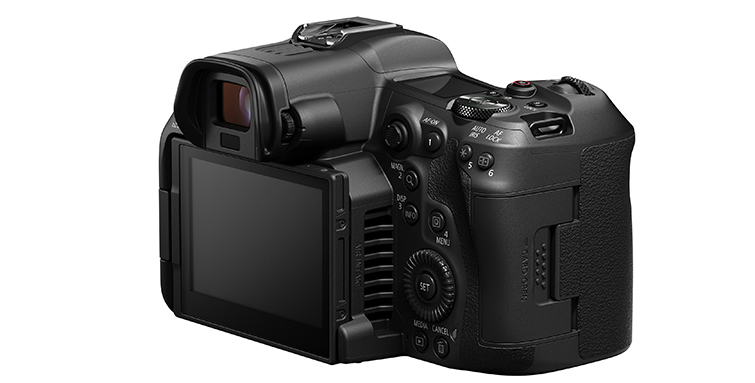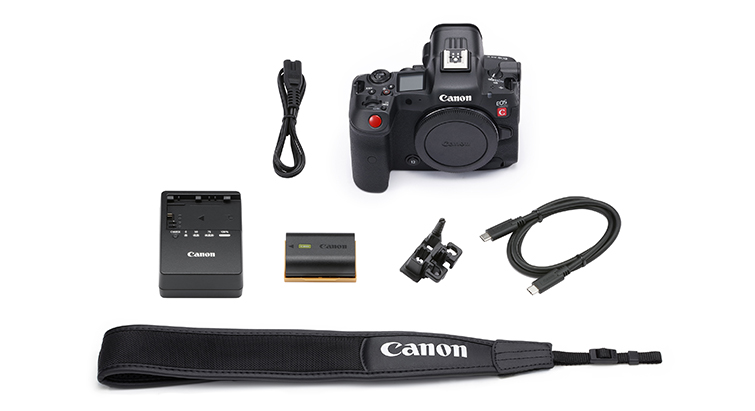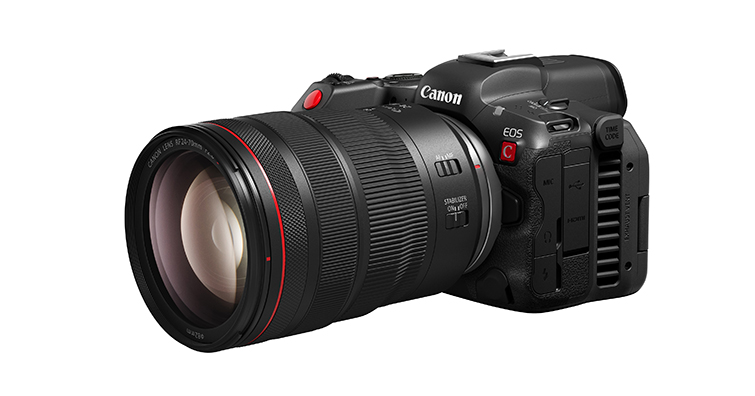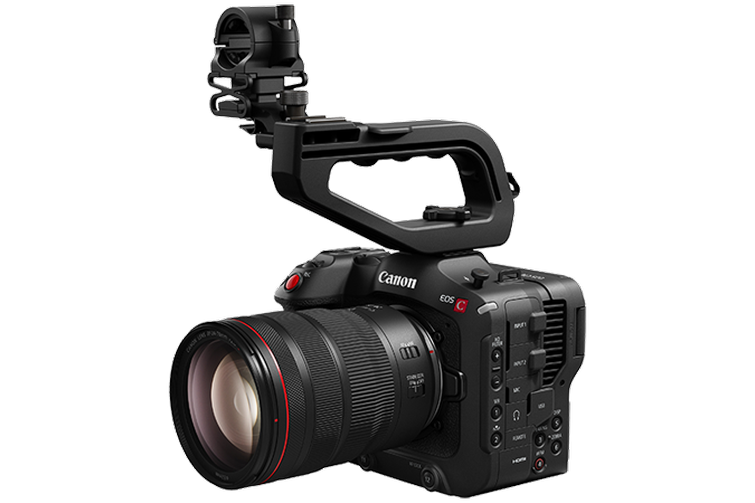
Canon Announces New Cinema Camera: EOS R5 C
We’re three weeks into 2022, and we have our first cinema camera announcement. Kind of. Here’s our Canon EOS R5 C review—specs included!
See, while Canon stated that we were set to receive a new entry into the Cinema EOS sphere, this still technically falls into the realm of hybrids. It’s part Cine shooter, part stills camera.
While the Canon C70 was Canon’s offering of a smaller but fully functional cinema camera, think Blackmagic’s Pocket Cinema line, this is more like an R5 on steroids. Somewhat akin to that of Sony’s FX3 to the A7S III.
We’ll talk a little about this further, but right out of the gate I’ll say this looks like the answer to any video shooter’s qualms with the R5.
These hybrid cameras will always be around, and with each subsequent release from major brands—like Canon, Sony, and FujiFilm—we’re getting closer and closer to getting the “perfect” camera. Just kidding. But the R5 C is close.
Let’s look at the features, shall we?
Key Features

- Full-frame 8K sensor: Capture professional 8K, 30fps footage (60fps with external power supply)
- 45 megapixel images: Shoot high-resolution 20fps (electronic) and 12fps (mechanical) images
- Long duration recording: Record 8K footage without limitations with a new active cooling system
- Dual pixel CMOS AF: Reliable autofocus performance featuring Eye AF and EOS iTR AF X
- Cinema RAW light: Internally record professional 12-bit RAW footage up to 2.6Gbps
- XF-AVC and MP4: Options for 4:2:2 10-bit XF-AVC 810Mbps recording and HEVC 540Mbps
- HDR recording formats: Produce high dynamic range content with Canon Log 3, PQ, and HLG capture
- Cinema EOS functions: Waveform Monitor, False Color, Timecode, and more
- Robust and compact design: Compact and lightweight (680g) body with dust and moisture resistance
One of the core criticisms of the R5, and one of the elements that caused subsequent memes, was the matter of how quickly it overheated. While it received firmware updates to dampen the issue, and third parties offered exterior solutions, it wasn’t perfect out of the box. The R5 C seeks to quash this issue altogether.
The EOS R5 C implements an internal active cooling system that efficiently dissipates heat from the main body and makes long-duration recording at 8K resolution up to 60p possible.
Like the larger cinema siblings, there are options for Always-On and Automatic Fan Modes. Which will allow users to minimize potential fan noise while recording.

However, unlike the R5, the R5 C will be without IBIS. Given the form factor of the camera, it’s likely the internal cooling system pushed this feature out. Further proving the sentiment that we truly can’t “have it all.” This move isn’t anything we haven’t seen before—looking at you Panasonic S1 and S1H.
And, talking about the form factor, it’s important to note that the EOS R5 C is now the most compact and lightweight Canon Cinema EOS camera, weighing only 680 grams, and with dimensions at 142 x 101 x 111 mm (5.6 x 4.0 x 4.4″). The camera basically looks like a hybrid between the C70 and R5.
So, while you might be thinking the features and specs for the R5 C could have all been in the R5—if Canon had just fine-tuned their product from the get-go—you wouldn’t be entirely wrong.
Recently, I wrote about camera manufacturers releasing these cameras that aren’t game-changers in any shape or form, and then marketing them as end-all-be-all cameras for shooters of every kind. Will the R5 C be the end-all-be-all? No, but it does seem like it has the potential to be a worthy camera.
So, let’s talk about video.
Video Capabilities

You’re going to see 8K as one of the selling points of this camera, and may be slightly confused, as 8K is a core factor of the EOS R5. This could be used up to 30p 8-bit H.264, 10-bit H.265, or 12-bit Canon RAW.
However, the EOS R5 C takes this further, offering 12-bit Cinema RAW Light (as used on other Cinema EOS cameras) at up to 8K/60p. So, this is clearly an extremely capable body that fills the gap the R5 left for hybrid shooters. This is a video-centric camera, so stills shooters might want to stick with the R5 if you’re interested in this system of cameras.
The EOS R5 C supports RAW output via HDMI for ProRes RAW recording with a compatible external recorder. When connecting the EOS R5 C with a supported external recorder, you can shoot in Apple ProRes RAW at up to 8K/30p. Proxy data can also be simultaneously recorded to an SD card in-camera, helping to provide efficient post-production operations.
Also, if you’re not shooting RAW, the R5 C can shoot XF-AVC footage (422 10-bit formats with MXF-wrapped H.264 AVC file with metadata) at up to 4K/120 in a choice of Long GOP or ALL-I modes. The alternative is MP4 files, primarily using H.265 Long GOP compression. You’ll be able to capture at 8K/30p.
Overall, this is a stellar addition to the Canon Cinema Camera lineup and should be a perfect segue from the DSLR era to the future.
Stills Functionality
As initially stated, although touted as a cine camera, the R5 C also houses the ability to shoot still images. Canon says:
The EOS R5 C’s full-frame sensor and DIGIC X processor work in unison to deliver high-quality 45-megapixel images, at up to 20fps with the electronic shutter, or 12fps with the mechanical shutter. The EOS R5 C’s Photo Mode also features Canon’s renowned Dual Pixel CMOS AF II technology, organic warm color science, and ISO sensitivity as high as 52,000 ISO, making the EOS R5 C an exceptional solution for professional photography.
– Canon
With that, we can see it shares the same 45MP Dual Pixel AF CMOS sensor with the Canon R5. Likewise, both cameras also share the 5.76M dot electronic viewfinders and fully articulating 2.1M-dot rear touchscreens. So, it’s not as if the R5 C lacks the functionality of a typical stills camera despite the EOS cinema function.
While both cameras have Canon’s Dual Pixel CMOS AF technology, the EOS R5 C has an enhanced version of this system featuring Eye AF and EOS iTR AF X. This is an advanced deep-learning algorithm that will recognize faces accurately (even when only one eye is visible) and will track a subject even when they look away from the camera.

In regards to recording formats—despite the increase in video power—like the R5, the R5 C still only has a single CFexpress slot and a UHS-II SD card slot.
Improved Video Focus
Of course, there has to be a slight shift towards filmmaking for this to be a marketable tool, and it does have quite a significant number of additions, although you’ll find they’re mainly internal. These new features include wave form monitor displays, a false-color overlay, and a desqueezed preview when shooting with anamorphic lenses. And, the R5 C also has the functionality to capture HDR footage in the HLG broadcast standard.
Outside of that, though, you won’t see many cinema-esqe functions added to the body like you’d find on the C70.
While some of the buttons have been renamed with additional functions (like how the on/off knob now rotates from photo to off to video), the body largely remains the same aside from the new fan. However, the R5 C does include a timecode socket through which it can synchronize with other devices.
Overall, we can see there aren’t that many new additions to the camera over the R5, however, I think it’s best to look at this camera as a video-focused variant, as opposed to an entirely new system.
Are you a photographer first who sometimes requires video? If so, gun for the R5. It’s more compact and has greater photo features like IBIS.
Are you a videographer who also shoots stills sometimes? Then the R5 C would be your choice. It has improved cooling and an assortment of additional video features.
Canon C70 Firmware Update

In addition to the announcement of the R5 C, Canon has also announced that a new firmware update will be live starting in March for all users of the Canon C70. The biggest feature of the new update is the inclusion of Cinema RAW Light.
Here’s what the press release says:
The addition of Cinema RAW Light internal recording to the EOS C70 camera further enhances the recording capabilities of what’s already a powerful digital imaging machine. This compact cinema camera can now capture 12-bit Cinema RAW Light internally to compatible SD cards.
Cinema RAW Light captures the widest dynamic range from the Dual Gain Output sensor (16+ stops total) and allows the most flexibility to grade captured content. Three quality settings of Cinema RAW Light will make their way into the EOS C70 via the firmware update.
The settings are: RAW HQ (high quality), RAW ST (standard quality), and RAW LT (light recording). All three modes are 12-bit regardless of frame rate. Lastly, Cinema RAW Light is compatible with Proxy and Double-Slot recording.
So, there you go. Another camera announcement and another firmware update. Somehow, I’m thinking 2022 is going to be a busy year for camera manufacturers and consumers alike.
I guess we’ll have to wait and find out!
In search of a few more filmmaking resources? We’ve got you covered:
- Cinematic Tips: Shooting 35mm with the Filmmakers of “Wake”
- Insta360 Go 2 Review: Too Many Compromises
- Selling Expensive Gear Online? Resale Outlets May Be Your Friend
- What Makes the iPhone 13’s Cinematic Mode Cinematic?
- Is It Worth Buying a Probe Lens in 2022?
Cover image via Canon.




